74. Plainville Historic Center
Ah Oui, Ville-de-Plaine
Plainville (Google Maps Location)
October 1, 2008
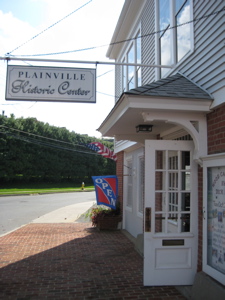 There comes a time in every person’s life where surprising things become a little bit less surprising. Take, for instance, going to 73 museums in Connecticut (as most everyone has) and upon deciding to go to another little town’s little historical museum – and once inside learning that it is large, informative, and downright great and not being too surprised about it. Such is my life.
There comes a time in every person’s life where surprising things become a little bit less surprising. Take, for instance, going to 73 museums in Connecticut (as most everyone has) and upon deciding to go to another little town’s little historical museum – and once inside learning that it is large, informative, and downright great and not being too surprised about it. Such is my life.
Plainville is plain. Really and truly. It has a Main Street and an Oak Street and a Maple Street within its 12 square miles. People live there, a train rumbles through on occasion and guys drink a few too many in one of the town’s bars. Heck, it doesn’t appear to even have a Wikipedia page yet. PLAIN. Ville. I had to spice up the joint by making it sound French and exciting in my blog title.
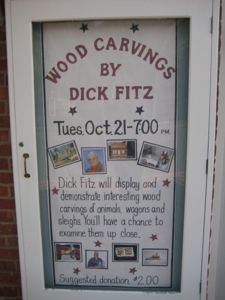
I’m too immature to write a caption for this.
Of course, even though it’s one of Connecticut’s younger towns, having only been incorporated from Farmington in 1869, its name derives from the plain it is built upon, not the vanilla offerings of the town. According to one site, Plainville is probably the most level township in the state. Nearly all of its area is in the broad open plain lying between the mountain ranges which run north from New Haven harbor to Vermont. Plainville rests upon a dividing ridge of water-shed, and is the highest bottom-land along the valley. Its measured altitude is 186 feet above tide-water. It is a current geological belief that the Connecticut River formerly flowed through this valley and was at a comparatively late day diverted by some convulsion near Mount Tom, in Massachusetts.
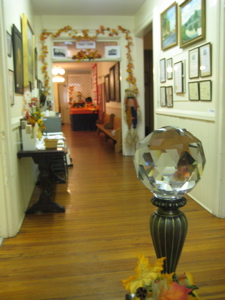 Yes, this interests me. And perhaps… Only me.
Yes, this interests me. And perhaps… Only me.
The land was always rather unremarkable, even to the Tunxis Indians way back when. The Plain, as Plainville was known when still part of Farmington, remained of little importance and with no significant business interests until the construction of the Farmington Canal. This remarkable though unfortunate work – an attempt in a small way to bring back the Connecticut River to its original path – was thrown open to business in 1826. Between here and tide-water at New Haven were about twenty locks to overcome the elevation (186 feet). But more on that later.
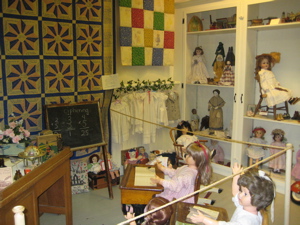 Let’s get going with the museum itself. Set right in the center of town, the Plainville Historical Society is located in the old Town Hall. It’s been there since the 1976 dedication and is far larger and more interesting than your average town history museum.
Let’s get going with the museum itself. Set right in the center of town, the Plainville Historical Society is located in the old Town Hall. It’s been there since the 1976 dedication and is far larger and more interesting than your average town history museum.
I was greeted at the door by a very nice woman named Gertrude (I think). Once again I was grilled about my intentions but kindly offered a tour – alone, as usual. I was led upstairs and immersed into the world of Plainville, Connecticut. A world which few have delved and fewer have cared to before me.
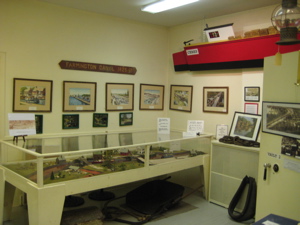 But I’m here to tell you, this museum is excellent. The first thing I noticed was how pleasantly it smelled and how clean it was. I was told later (upon remarking how lovely the whole building smelled), that they use those plug-in scent release things. Dreamy.
But I’m here to tell you, this museum is excellent. The first thing I noticed was how pleasantly it smelled and how clean it was. I was told later (upon remarking how lovely the whole building smelled), that they use those plug-in scent release things. Dreamy.
The first few rooms I saw upstairs were typical town museum fare. That’s not to say there weren’t presented well – they were! I was distracted, as I always am, by the sheer volume of creepy dolls. I was accused in a past museum visit of not alerting the readers to the forthcoming creepy doll pictures – so be forewarned, there are many below.
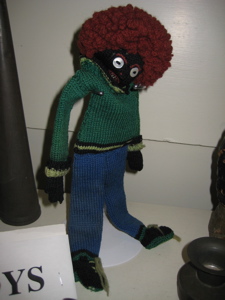 First up: the Children’s Room. From the PHS website, this room “was the former Assessor’s Office. It shows the type of toys children played with in by-gone years – a collection of dolls, games, toys and also samples of clothes, some of which date back to the early 1800′s. One of the highlights of the room is a beautiful old doll house.” The doll house was finished in 1913 and has toy furniture in it from FAO Schwarz in New York City. Almost all of the pieces in the doll house are originals.
First up: the Children’s Room. From the PHS website, this room “was the former Assessor’s Office. It shows the type of toys children played with in by-gone years – a collection of dolls, games, toys and also samples of clothes, some of which date back to the early 1800′s. One of the highlights of the room is a beautiful old doll house.” The doll house was finished in 1913 and has toy furniture in it from FAO Schwarz in New York City. Almost all of the pieces in the doll house are originals.
I wrote a note from my guide day which says, “doll house; guy on Titanic lived; fam died.” I’m writing this entry three and a half months later and I think I remember that the guy who built the dollhouse by hand survived the Titanic but his whole immediate family died so he had the time and devotion to his nieces for which he built the doll house. Or at least something close to that.
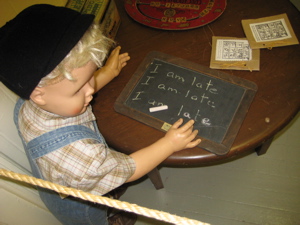
Creeeeeeee…
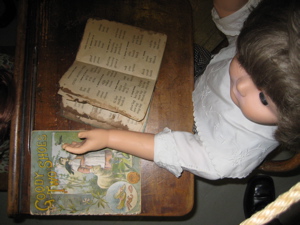
…pyyyy
The room also has a little schoolroom set up with the aforementioned creepy dolls attending. There is a chalkboard in the back with the word, “ciphering” on it, which struck me as odd. Even now, it’s still weird. Weirder still? Plainville Historical Society: Big on history, not so much with the maths:
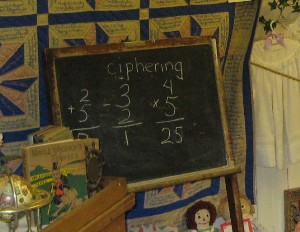
Moving on, the “Country Kitchen was the former Tax Office and depicts a turn-of-the century kitchen with utensils, furniture and gadgets of the era (1890-1910). There’s a display of tinware, some of which was produced right yhere in Plainville!” Certainly not the biggest old timey kitchen display I’ve seen in my travels, but it was CLEAN and presented very nicely. The highlight for me was noticing something called a “sad iron.”
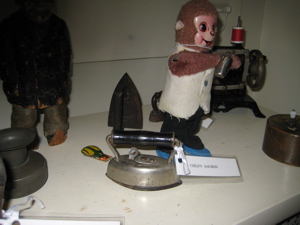
A monkey and a sad iron. Big ups.
I tried to cheer it up with some creepy doll play to no avail. I learn something everyday writing this blog (From Here): “One meaning of sad in nineteenth century dictionaries was “heavy.” Although many of these irons were small, they were very heavy. When sad irons were heated near an open fire or on the stove, their handles became red hot. Women tried wrapping aprons or towels around the handles, but still burned their fingers.” I’d think that would make those 19th century women sad indeed.
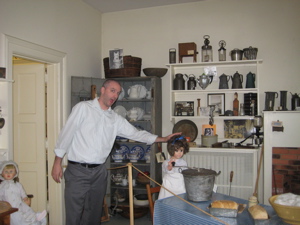
I like to touch them sometimes.
Some lady named Mary F. Potts endeared herself to countless women when she patented a much lighter sad iron with a detachable wooden handle. Yay! I’m sure her husband took all the credit though. Ahhh, 19th century had its charms.
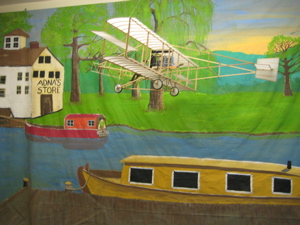 Across the hall – wait a minute, the hall is pretty cool unto itself. It contains a random Statue of Liberty model for some reason but also a model airplane from the infancy of aviation. It turns out our little Plainville is home to some serious aviation history – on two fronts.
Across the hall – wait a minute, the hall is pretty cool unto itself. It contains a random Statue of Liberty model for some reason but also a model airplane from the infancy of aviation. It turns out our little Plainville is home to some serious aviation history – on two fronts.
The plane belonged to one Mr. Nels Nelson, who, in 1911 first flew his 33-foot “flying machine” from the Scott Swamp District off present Route 177 in Plainville. He was a daring 22-year-old from New Britain who went on to put on flying exhibitions around the country. Who knew?
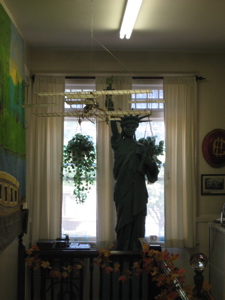
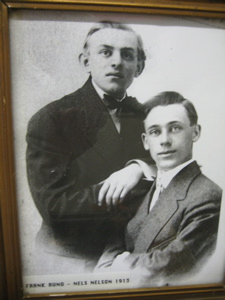
Also, I learned all about the little local airport, Robertson Field. Opened in 1911, it is the oldest airport in Connecticut! (CTMQ Visit here!) Furthermore, John H. Trumbull, a Plainville native and Connecticut’s Governor from 1925 to 1931, is known to have used the airfield. He was dubbed “The Flying Governor”. My guide told me that Trumbull was actually a terribly pilot who had a habit of bad landings – but somehow never died doing so.
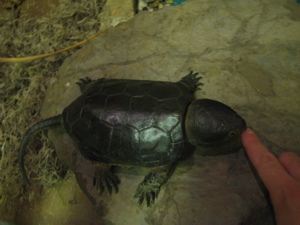 I didn’t expect a hallway to contain so much interesting stuff. Up next was the Tunxis Room. Says they, “The Tunxis Room was the former office of the Judge of Probate. There is an impressive collection of Morris Hart’s Indian artifacts, which include arrow points, hammer stones, paint pots, knives, scrapers, and a huge pestle, that’s 31 inches long, and other related items. All of the pieces were discovered within a 10-mile radius of Plainville. There is also a collection of minerals which were from Plainville and donated by Tilcon Tomasso Inc. and a collection of birds of prey.”
I didn’t expect a hallway to contain so much interesting stuff. Up next was the Tunxis Room. Says they, “The Tunxis Room was the former office of the Judge of Probate. There is an impressive collection of Morris Hart’s Indian artifacts, which include arrow points, hammer stones, paint pots, knives, scrapers, and a huge pestle, that’s 31 inches long, and other related items. All of the pieces were discovered within a 10-mile radius of Plainville. There is also a collection of minerals which were from Plainville and donated by Tilcon Tomasso Inc. and a collection of birds of prey.”
Tomasso, by the way, owns Robertson Airport at the present (though Plainville is seeking to buy it) as well as just about every quarrying, paving, and construction operation in the state. I learned a lot about the Tomasso patriarch earlier in the day over at the New Britain Library History Room (CTMQ visit here!).
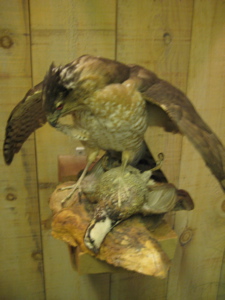
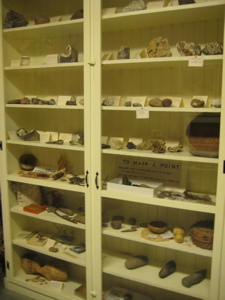
Certainly a unique type of room to have in a town history museum, and one which I thoroughly enjoyed. Once again my projeced time for this museum was to be doubled in reality. Oh well. Especially since my favorite room was up next – the Canal Room.
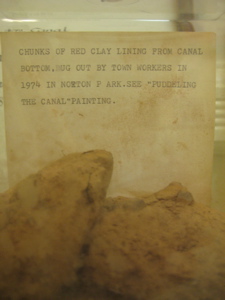 “The Canal Room was the former Town Planner’s Office and Highway Superintendent. The focal point in the room is a large diorama of the canal (1828-1848) which depicts the center of town (known as Bristol Basin). It has Whiting’s General Store, the tavern, bridges, a packet (passenger) boat and a freighter. The buildings shown were actually present during canal days. There is also a big canal tin horn which was sounded when boats were coming into the basin or to warn of low bridges. Bills of lading, time schedules, books, maps and more can be found in the collection.”
“The Canal Room was the former Town Planner’s Office and Highway Superintendent. The focal point in the room is a large diorama of the canal (1828-1848) which depicts the center of town (known as Bristol Basin). It has Whiting’s General Store, the tavern, bridges, a packet (passenger) boat and a freighter. The buildings shown were actually present during canal days. There is also a big canal tin horn which was sounded when boats were coming into the basin or to warn of low bridges. Bills of lading, time schedules, books, maps and more can be found in the collection.”
The Farmington Canal was a colossal failure, by all measures. On the heels of the completion of the Erie Canal in New York State, a group of New Haven businessmen met in 1821 with the goal of constructing a canal in Connecticut to facilitate trade. Ground was first broken on July 4, 1825. It was completed in 1835.
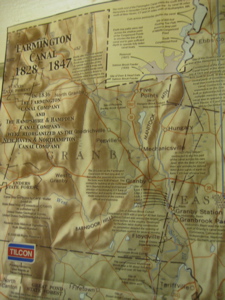 The canal was not cheap to build, and the finances of the construction and upkeep of the canal were always precarious. Railroads put an end to the use of the canal. Just 12 years after the canal was completed, a rail bed was laid to cover the same route the canal had traversed. Whoops. For far, FAR more information on this fascinating and enduring bit of Connecticut history, the nerds at Yale have a great article.
The canal was not cheap to build, and the finances of the construction and upkeep of the canal were always precarious. Railroads put an end to the use of the canal. Just 12 years after the canal was completed, a rail bed was laid to cover the same route the canal had traversed. Whoops. For far, FAR more information on this fascinating and enduring bit of Connecticut history, the nerds at Yale have a great article.
At the back of the building, The Courtroom was at one time the former Town Courtroom and is used for our summer displays and meetings. Hanging on the walls are a number of Alfred Hepworth’s (1876-1962) paintings. I only mention this because one of the paintings is of The Pinnacle which is along the Metacomet Trail. Perhaps the coolest thing about Plainville is along this section of the trail – wild cacti! (CTMQ hike here!)
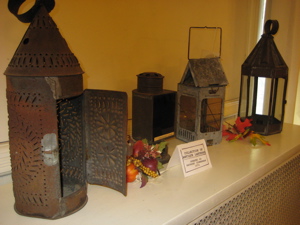
Also in the Court Room: A collection of antique lanterns for some reason. I love my blog.
The last room upstairs is the Victorian Room. “The Victorian Parlor was the former Town Manage’s Office and Conference Room. It is adorned with antique furnishings which once decorated the rooms of local mansions. Some of the items on permanent display in the room are a five foot mirror with fabulous carvings and gold trim, which came from the Hills Mansion, a velvet window seat donated by Mr. and Mrs. John Coolidge which came down through the Usher family to Maude Pierce Usher the mother of Mrs. Coolidge (circa 1800), and a huge round dining room table from Henry Trumbull’s Mansion, just to name a few. The theme accurately depicts Plainville life as it was in the 19th century.”
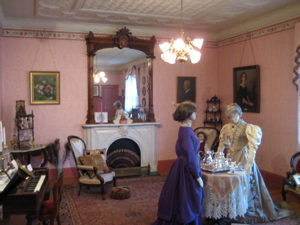
There was, of course, also a few creepy dolls in there but they didn’t take away from the impressiveness of the room. I’m no fan of Victoriana, but this was one of the better presentations I’ve come across.
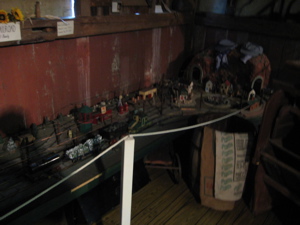 I then went downstairs, through the museum store (“Our store has a variety of early American toys, books on local histories, gifts and stationery items. Some of the new merchandise to the store are a Connecticut coloring book, cast iron banks which are exact replicas of authentic antiques, different styles of Old English Lanterns, Victorian note pads and stickers, and old fashioned hard candies.”) and back into the Barn Room. “The Barn Room was the former Engineering Office. It was created from barn lumber and beams which were salvaged from four area barns. On display is a collection of farm tools, implements and a Roger’s Bakery wagon which is known to have been used to deliver bread in the early 1900′s.”
I then went downstairs, through the museum store (“Our store has a variety of early American toys, books on local histories, gifts and stationery items. Some of the new merchandise to the store are a Connecticut coloring book, cast iron banks which are exact replicas of authentic antiques, different styles of Old English Lanterns, Victorian note pads and stickers, and old fashioned hard candies.”) and back into the Barn Room. “The Barn Room was the former Engineering Office. It was created from barn lumber and beams which were salvaged from four area barns. On display is a collection of farm tools, implements and a Roger’s Bakery wagon which is known to have been used to deliver bread in the early 1900′s.”
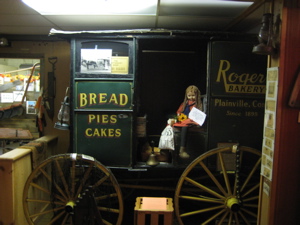
Creepy dolls are EVERYWHERE here
There is also a working antique train display which I was most interested in. And what museum is complete without an antique bee-keeping mask? Shame on you every other museum in the world for not having one. The last room to check out was the Tool Room.
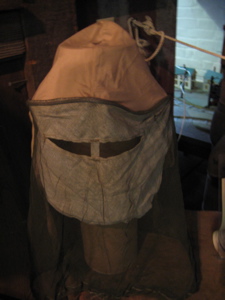 The Tool Room has on display a large collection of woodworking tools, icing tools, and pictures. Also on display in that room is basting thread, spools, scissors and undergarments from the Plainville Manufacturing Co. (1850-1930′s) knitting mill. I can’t believe I didn’t get a picture of any old timey undergarments. I’m sure my Google hits would increase with a good shot of something like that. I guess that’s reason enough to return again in the future.
The Tool Room has on display a large collection of woodworking tools, icing tools, and pictures. Also on display in that room is basting thread, spools, scissors and undergarments from the Plainville Manufacturing Co. (1850-1930′s) knitting mill. I can’t believe I didn’t get a picture of any old timey undergarments. I’m sure my Google hits would increase with a good shot of something like that. I guess that’s reason enough to return again in the future.
I ended my tour with a lengthy chat with a couple women who volunteer (work?) at the museum. They were working on the website I used for much of my write-up and were very excited about a new printer. They were also excited to have me visiting and showing an interest in the town’s history – especially since I wasn’t from the town. I was invited on a field trip to the local Tomasso quarry which is now half a mountain across I-84 – Check it out in Google Streetview – but that didn’t seem too enjoyable to me.
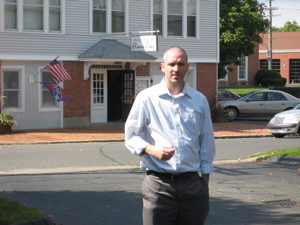
My oddly tentative CTMQ thumbs-up pose. (I had placed my camera on a large pickup truck and between the time of pushing the 10 second timer and walking over to pose, a rather large man began walking towards me. It turned out he was only getting his mail, but still.)
I loved this museum. Once again I was blown away by the volume and richness of the Plainville collection. I’m not sure I’ll ever stop being surprised by this stuff. Plainville is not Connecticut’s most interesting town by any stretch and even though I’ve driven through it a few hundred times by now, I learned I knew nothing about it at all.
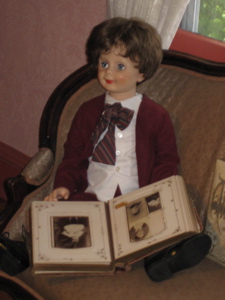
Ahhaahhhaaahh!
…………………………………………………….
Cost: Free (donations accepted)
Hours: See website (They differ seasonally)
Food & Drink? People seem to enjoy the nearby Sliders
Children? Yes, but don’t dawdle
You’ll like it if: You’re more Ville than Plain
You won’t like it if: You want to keep the “plain” in Plainville
Freebies: None
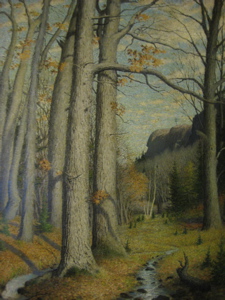
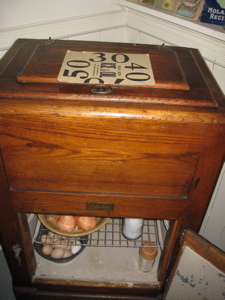
For the Curious:
Plainville Historic Center
Robertson Airport
Nels Nelson
Farmington Canal Trail
All about the failed Farmington Canal






Steve,
I grew up in P-ville right around the corner from this awesome place. Being the huge nerd that I am, many hours were spent in here and the cool museum in the library. (Did you know about that one?) I love Plainville even if it is a little drunk and whitetrash…lol.
Talk to so soon,
Comment #1 on 05.24.09 at 4:24 pmMindy
[...] he’s explored and reviewed several dozen. He’s noticed a disturbing pattern, though: Creepy Dolls. This is not a problem exclusive to Connecticut. I submit the following evidence from Watertown, [...]
Comment #2 on 08.06.09 at 5:37 pmI am looking for any information or pictures about Hugh Rockwell’s monoplane, that might have been built at Rockwell-Drake in 1917.
Robert Rockwell
Comment #3 on 02.23.13 at 8:25 am